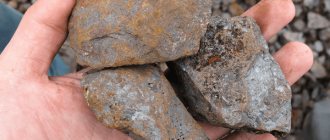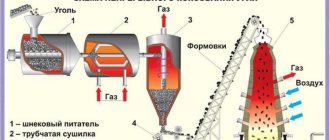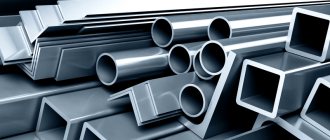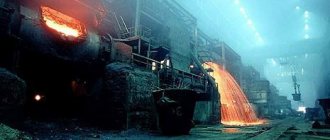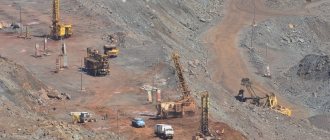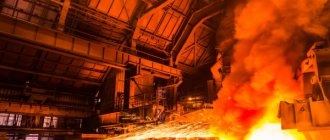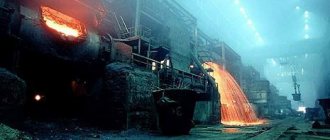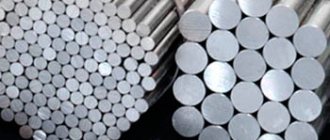The production of ferrous and non-ferrous metals has long been one of the main industrial areas. Thanks to metallurgy, people are provided with materials used for the construction of various structures in many technological fields. Until the 70s of the last century, the metallurgical industry developed at an accelerated pace, but then there was a slight decline in activity associated with a decrease in metal production capacity. Today, metallurgy has taken a course of development in the following directions:
- targeting consumer needs;
- increased interest in developing transport routes instead of exporting raw materials.
- preference for the development of enterprises with small and medium-sized capacities;
- bias towards the development of the industry in developing countries.
The metallurgical industry is divided into the production of ferrous and non-ferrous metals.
Development of ferrous metallurgy in the world
Ferrous metallurgy involves the following stages:
- development of ore deposits;
- raw materials preparation;
- smelting of materials such as cast iron, steel, rolled products and ferroalloys.
Stages of ferrous metallurgy
Ferrous metallurgy uses ore containing metals such as iron, chromium and manganese as the basic feedstock. In addition, many enterprises work with recyclable materials, such as depreciation scrap and metallurgical waste.
The use of scrap can significantly reduce the cost of production, since the stage of casting iron is skipped and the process of producing steel begins immediately. Coking coal is used as fuel for iron production.
Full cycle ferrous metallurgy produces its own product at each stage. Depending on this, there are several types of enterprises, such as:
- small capacity plants;
- metallurgy enterprises;
- full cycle plants;
- enterprises for the production of ferroalloys;
- electric steel plants.
In accordance with the location of coal or iron ore basins, ferrous metallurgy was often inconsistent in its localization. In the current period of scientific and technological breakthrough, the guidelines have shifted towards fuel and raw materials cargo flows.
Thanks to this, the size of enterprises under construction is reduced, and their geographical location does not depend on the deposits. For example, metallurgical plants in Western European countries and Japan are now located in areas with access to a seaport.
Major countries in iron ore mining
The deposits are developed by different countries, leaders in production, however, not all of them. Until the 40s of the last century, the main development of iron ore deposits was carried out by Germany, France, the USA, Great Britain and Sweden. In the post-war years, these countries lost their championship to South Africa, Australia, Canada and the USSR. Today the situation has changed somewhat, and the following countries are leading in this area:
- China;
- Brazil;
- India;
- CIS;
- Australia.
More than 40 countries in the world are engaged in the development of ore deposits, and the total amount of mined minerals is almost 1 billion tons. Approximately 70% of the total ore mined comes from countries such as China (23%), Brazil (17%), Australia (13 %), Russia (9%), India (8%).
Despite the impressive volumes, not all of these countries export this type of raw material. Australia and Brazil are the most important exporters, accounting for more than half of the world's exports.
Some countries that export iron ore resources also import it. Such countries include China, the USA, Italy and the UK, since on their territory there are full-cycle enterprises characterized by increased production material intensity.
In this case, the consumption of raw materials and fuel used exceeds the amount of cast iron produced by 4–5 times by weight. The costs of iron ore are especially significant compared to coking coal.
For this reason, the most economically advantageous locations for full-cycle plants are areas rich in raw materials and fuel at the same time. Representatives of such states are Ukraine, India, China, Australia. In other cases, centers of ferrous metallurgy arose near iron ore or coal deposits.
The localization of metallurgical centers in coastal areas provides an alternative for sea supplies of coal and iron ore. Sometimes the exploitation of imported raw materials and fuel is more profitable than the development of our own deposits.
In particular, India and Latin America transport iron ore raw materials by sea to the coastal plants of Japan, and Australia and China transport energy raw materials. Coal is supplied to EU countries in the same way from the USA, and ore is supplied by Brazil and South Africa.
Iron production
The main intermediate product in the ferrous metals production process is cast iron, which produces 50% of the world's total steel. Recently, the volume of the cast iron industry has been slowly declining, since it is economically unprofitable and pollutes the atmosphere. Since the early 90s of the last century, China has occupied a leading position in cast iron production; before that, the USSR had the lead.
Ferrous metals | Import and Export | 2021
Volume of global exports of goods of the Ferrous Metals group in 2019
exceeded
$349 billion
(according to reports from
130 countries
). A year earlier, this figure amounted to $419 billion (according to 155 countries).
For 2021, there is no data yet on the exports of such participants in the global market of goods of the Ferrous Metals group as Ukraine (2.36% of world exports in 2021), Iran (0.93%), Oman (0.31%), Bahrain (0.165%), Dominican Republic (0.096%), Albania (0.071%), Libya (0.043%), Lebanon (0.029%), Uganda (0.02%), Tanzania (0.011%), Montenegro (0.008%), Mozambique (0.002%), Angola (0.001%)
Which countries exported Ferrous Metals in 2021?
The main exporters of goods in this group in 2021 were
- China - 11.2%
of world exports ($39 billion) - Japan - 7.45%
(26 billion) - Germany - 7.29%
(25 billion) - South Korea - 6.6%
(23 billion) - Russia - 5.2%
(18.1 billion)
Ferrous metals make up a significant portion of exports
- Luxembourg - 11.8%
of Luxembourg exports in 2021 in 2021 ($1.74 billion from $14.6 billion) - Georgia - 9.32%
(354 million out of 3.79 billion) - North Macedonia - 7.68%
(552 million out of 7.18 billion) - Palestine - 6.04%
(66 million out of 1.1 billion) - Kazakhstan - 6.01%
(3.47 billion out of 57 billion)
According to the reports of the main exporters, the largest trade flows for the export of ferrous metals in 2021 were
- Exports from Belgium to France (0.915% of world exports, $3.2 billion according to Belgium reports)
- Exports from Brazil to the US (1.12% of world exports, $3.94 billion as reported by Brazil)
- Exports from Canada to the USA (1.4% of world exports, $4.92 billion as reported by Canada)
- Exports from China to South Korea (1.46% of global exports, $5.13 billion as reported by China)
- Exports from China to Vietnam (1.04% of world exports, $3.64 billion as reported by China)
- Exports from Japan to China (1.17% of world exports, $4.12 billion as reported by Japan)
- Exports from Japan to South Korea (1.41% of world exports, $4.93 billion as reported by Japan)
- Exports from Japan to Thailand (1.09% of world exports, $3.82 billion as reported by Japan)
- US exports to Canada (1.03% of global exports, $3.63 billion as reported by US)
- US exports to Mexico (1.17% of global exports, $4.11 billion as reported by US)
Volume of global imports of goods of the Ferrous Metals group in 2019
exceeded
$367 billion
(according to reports from
132 countries
). A year earlier, this figure amounted to $429 billion (according to 156 countries).
For 2021, there is no data yet on the import of such participants in the global market of goods of the Ferrous Metals group as Oman (0.413% of world imports in 2021), Ukraine (0.318%), Iran (0.281%), Ethiopia (0.187%), Dominican Republic (0.163%), Lebanon (0.155%), Tanzania (0.099%), Uganda (0.086%), Bahrain (0.081%), Albania (0.057%), Libya (0.053%), Angola (0.053%), Sudan ( 0.044%), Mozambique (0.03%)
Which countries imported Ferrous Metals in 2021?
The main importers of goods in this group in 2021 were
- Germany - 7.43%
of world imports ($27 billion) - USA - 6.69%
(24 billion) - China - 6.35%
(23 billion) - Italy - 5.27%
(19.3 billion) - South Korea - 4.26%
(15.6 billion) - Turkey - 4.09%
(15 billion)
Ferrous metals make up a significant portion of imports
- Turkey - 7.15%
of Turkey imports in 2021 in 2021 ($15 billion out of $210 billion) - Uzbekistan - 6.53%
(1.42 billion out of 21 billion) - Burundi - 6.27%
(55 million out of 887 million) - Pakistan - 6.18%
(3.09 billion out of 50 billion) - Indonesia - 6.07%
(10.3 billion out of 171 billion) - Comoros - 5.8%
(11.6 million out of 201 million)
According to the reports of the main importers, the largest trade flows of imports of Ferrous Metals goods in 2021 were
- Imports to China from Japan ( 1.28%
of world exports,
$4.71 billion
according to China reports) - Imports to Germany from Belgium ( 0.935%
of world exports,
$3.43 billion
as reported by Germany) - Imports to Germany from France ( 0.936%
of world exports,
$3.44 billion
according to Germany reports) - Imports to South Korea from China ( 1.46%
of world exports,
$5.38 billion
according to South Korea reports) - Imports to South Korea from Japan ( 1.42%
of world exports,
$5.24 billion
according to South Korea reports) - Imports to Mexico from the USA ( 1.13%
of world exports,
$4.16 billion
according to Mexico reports) - Imports to Thailand from Japan ( 1.04%
of world exports,
$3.83 billion
according to Thailand reports) - Imports to the US from Brazil ( 0.963%
of world exports,
$3.54 billion
according to US reports) - Imports to the US from Canada ( 1.31%
of world exports,
$4.83 billion
according to US reporting) - Imports to Vietnam from China ( 0.922%
of global exports,
$3.38 billion
according to Vietnam reports)
Leading in steel production
Steelmaking is considered an important process in the iron and steel industry.
Typically, cast iron is supplied as a primary raw material for the production of steel, but increasingly, blast furnace production is being replaced by the use of recyclable materials in the form of scrap metal. Thanks to the scientific and technological revolution, modern technologies have practically replaced the old methods of producing steel.
Electrothermal and oxygen-envelope methods consume less resources, reduce energy costs and smelting time. A new technique for producing steel by processing metallized pellets made it possible to abandon classical cast iron production and build steel plants regardless of the location of iron ore deposits.
The main producing countries of ferrous metallurgy are:
- China;
- Japan;
- USA;
- Russian Federation;
- Germany;
- South Korea;
- Brazil;
- India;
- Italy.
Leading countries in the production of non-ferrous metals
Non-ferrous metallurgy is divided into two large industries: heavy (production of Pb, Cu, Zn, Sn, Ni) and light (production of Al, Mg, Co, Ti, Li, Be and other metals). In terms of production scale, the metallurgy of ferrous metals exceeds non-ferrous metals by approximately 20 times.
Typically, non-ferrous metallurgy plants are built depending on the location of the deposits, since the amount of valuable metal in the ore is insignificant.
Other factors influencing the localization of non-ferrous metallurgy plants:
- energy;
- consumer;
- transport.
The initial production stages of copper, involving the extraction and beneficiation of ore, are localized in third world countries. Countries that do not have large copper reserves are focused on the final products of the production cycle.
The leading countries in copper production are occupied by the following countries:
- Chile;
- USA;
- Indonesia;
- Canada;
- Russia.
Transporting aluminum ore is more cost-effective than heavy metal raw materials, since the aluminum content of bauxite is about 50%. The total distance of bauxite transportation by sea is more than 7 thousand km, since their main deposits are located in regions with tropical and subtropical climates.
Countries producing the largest volumes of aluminum ore:
- Australia;
- Guinea;
- Jamaica;
- Brazil.
In aluminum production, the leadership is occupied by the USA, Germany, Japan, Norway, Russia, and Canada.
Production of cast iron and steel in leading countries of the world
| Place | A country | Cast iron, million tons 1992 | Steel, million tons 1994 | Cast iron and steel 1992 | |
| exports, billion dollars | imports, billion dollars | ||||
| 1 | Japan | 81,1 | 96,3 | 1,0 | 2,1 |
| 2 | China | 69,5 | 91,5 | 0,4 | … |
| 3 | USA | 44,9 | 88,9 | 0,4 | 1,76 |
| 4 | Russia | 48,9 | 48,6 | 4,5* | … |
| 5 | Germany | 31,0 | 40,8 | 2,6 | 2,5 |
| 6 | Türkiye | 32,9 | 36,0 | … | … |
| 7 | The Republic of Korea | 18,7 | 33,8 | 1,2 | 1,7 |
| 8 | Italy | 12,0 | 26,1 | … | 1,8 |
| 9 | Brazil | 23,5 | 25,7 | 2,4 | … |
| 10 | Ukraine | 20,0 | 23,9 | … | … |
* USSR, 1991
Ukrainian factories are in a slightly better position, but they are based on low-quality iron ore from the depleted Krivoy Rog basin and expensive Donetsk coal.
The US metallurgy industry, once the largest in the capitalist world, has greatly reduced production due to competition from imported metal. Nevertheless, today the United States is the world's third largest metal producer and, most importantly, the largest metal market, consuming significant quantities from other countries. In the eastern United States, traditional full-cycle ferrous metallurgy predominates, producing higher-quality metal. In the West and South, conversion metallurgy predominates, producing ordinary grades of steel mainly for construction. Initially, the centers of US metallurgy were concentrated in the areas of the Pennsylvania coal basin: iron ore came to them along the Great Lakes from Duluth. Then, at the intersection points of ore and coal flows, American metal began to be built, especially in Detroit, then around Chicago, where the largest metallurgical plant in the United States was located for a long time. Finally, steel plants began to spring up near major consumer markets, such as the plant at Sparrows Point, near Baltimore, which was originally built to supply a major engineering and shipbuilding center and then grew beyond its planned size to become a large steel mill operating on American coal and imported iron ore. In parallel, a metallurgical complex developed in Alabama (Birmingham), where a plant producing ordinary metal was founded using a combination of iron ore and coal, and then over time, with the general movement of American industry to the South, the production of high-quality metal began. After World War II, a number of new metallurgical centers were created in the far West, but they were unable to take over the functions of the country's main metallurgical base, which for a long time remained the traditional areas of Pennsylvania and Chicago. And only since the 60s. significant progress began with the creation of processing plants and their more uniform distribution.
This scheme has, to a certain extent, preserved the domestic market for metallurgy, while the West Coast of the United States is largely supplied with metal from the Far East, and on the East Coast there is serious competition with metal from Russia and Brazil.
Western Europe continues to occupy an important position in the global metallurgy, supplying domestic markets and exports with specialized grades of steel and rolled products. The shift to the sea is determined by a focus on imported iron ore and coal, especially since the import of American and South African coal is more profitable than the exploitation of depleted European basins. Even Ruhr coal turns out to be uncompetitive and is added to the charge of Ruhr coke ovens in connection with social support for miners and ensuring a minimum capacity in case of disruption of ties in the world economy. Political and military-strategic considerations force the support of unprofitable coal mining not only in the Ruhr, but also in Great Britain, where coal is less expensive, but also uncompetitive in comparison with “overseas” coal. In fact, all factories in Germany are connected in one way or another with waterways. The old Ruhr factories have survived only in those places where it is easy to deliver iron ore - from Rotterdam along the Rhine and canals, as well as coal from the Ruhr basin, which still retains some positions in the market for coking and thermal coals. However, the general trends in the development of European metallurgy are such that without a transition to cheap American, South African and even Russian coal, the metal will even lose the EU markets.
Italy took second place in Europe in steel smelting, whose metallurgy, oriented from the very beginning on American coal and African iron ore, was located in ports after the war. Only a few high-quality steel plants remained in those places where traditional Italian metallurgy was located, mainly in the Alps with small ore deposits, and even those were largely based on imported raw materials.
Unlike Italy, three areas of ferrous metallurgy have developed in France. On the one hand, these are the old factories in Lorraine - a relic of a once large metallurgical region that arose from large reserves of low-grade iron ore (iron content up to 40%). On the other hand, there are two new giant plants in Dunkirk and Marseille, where 2/3 of all steel is smelted.
Much the same fate befell the ferrous metallurgy of Belgium and Luxembourg, which also originated on local iron ore and coal, but has been operating on imported ore and coal for decades.
And only the English iron and steel industry, having moved to the ports, still partially works on its own coal, the extraction of which enjoys government support, since even the richest coal deposits in Europe in the new basins of Great Britain produce coal that is 20% more expensive than South African coal in the same English ports. So the transition to imported coal here is only a matter of time.
Outside the Western European region of iron and steel industry, which also includes factories in Spain, Sweden and the Netherlands, after 1945 metal production grew steadily in Poland (Silesia) and the former Czechoslovakia, where a new metallurgical center arose within the western part of the CMEA region. Now it has lost its traditional sales markets and has entered the world market, where it supplies metal. As a result, the region's metallurgy operates at only 2/3 of its capacity. Her fate is not yet clear; for now it is supported by relatively low wages, the rates of which occupy an intermediate position between Western European standards and the wages of metallurgists in developing countries.
Since the beginning of the 90s. The metallurgy industry in China is growing rapidly, where rapidly developing industry and construction place a huge demand for metal. China has taken second place in the world in steel production, remaining its largest importer. If in 1990, with the production of 65 million tons of steel, imports amounted to about 10 million tons, then in 1993, with the production of 87 million tons, imports doubled, and a significant share of it came from Russia. In the near future, China may become the main steel producer, surpassing the 100 million tons mark.
China's iron and steel industry has gone through several stages of development. The first factories were concentrated in a few areas, primarily in Manchuria: the plant in Anshan remains the country's largest producer (about 10 million tons of steel) and was located near large coal and ore deposits. Large factories in Baotou and Wuhan had a similar orientation towards raw materials. However, on the vast territory of China, placement only in points that were optimal in relation to raw materials could not fully satisfy the demand for metal in all regions of the country. Therefore, the very principles of location changed and the construction of small factories began, more evenly distributed across the provinces of China. By the end of the 80s. About 1,400 plants were built in China, but only 14 of them had annual production exceeding 1 million tons of steel. The metallurgy of coastal regions, focused on ore imports due to the low quality of local raw materials, is expanding most rapidly.
By 1993, China had five large plants with a capacity of over 5 million tons - Anshan, Baoshan, Shungan, Wuhan and Baotous, 17 plants with a capacity of 1 million tons and 21 plants with a capacity of 500 thousand to 1 million tons of steel. Two large metallurgical plants are in the process of construction and expansion - in Wuhan from 5 to 7 million tons and a plant in Maanshan - up to 5 million tons. Only 60% of the steel was smelted using the oxygen-converter method, and the share of open-hearth smelting is still large. Therefore, one of the main ways to expand production is the reconstruction of ferrous metallurgy enterprises. Another problem was the weakness of the iron ore base: China already meets 20% of its needs through imports, and this figure could increase to 35%. Despite the rapid growth in steel production, which may reduce the need for imports, it is expected that even in 2000 a significant part of the demand for pipes and sheets will be met through imports and only by 2021 will China begin to fully satisfy its needs for ferrous metals.
Modern non-ferrous metallurgy. It has two main types of products: the production of primary and the production of secondary metal. The first is produced from ores extracted by mining, and the second by melting scrap non-ferrous metals. Moreover, the role of recycled metal is constantly increasing as stocks of used products accumulate. In the early 90s. On average, in developed countries, 25-30% of copper and aluminum and up to 40-50% of lead were produced from scrap.
In terms of production volume, non-ferrous metals vary markedly. For mass metals, for example, aluminum, the annual smelting volume in the world is about 12-15 million tons of primary aluminum and 6-7 million tons of secondary metal; Thus, in total, depending on the situation, 19-22 million tons of “white” metal. For copper (the second most important non-ferrous metal), the figures are much more modest - 10 million tons. The production of zinc and lead is even less, but their smelting reaches millions of tons. The picture is completely different in the production of “medium-scale” metals - nickel, tin, magnesium: the scale of their production ranges from 100 thousand to 500 thousand tons. And finally, there is a group of rare metals, where production values range from 10 thousand tons, as in the production of tungsten and molybdenum, up to several tens of tons (germanium). Gold is far from the rarest metal currently mined; its total production is estimated at about 25-30 thousand tons, although it varies sharply from year to year.
The leading non-ferrous metal in the modern world is aluminum. Due to complex production technology, different stages are located in different countries and very often do not coincide with the extraction of raw materials, but are focused on cheap electricity. The first stage of aluminum production is
bauxite mining - focuses on rich deposits in Australia, Guinea, and Jamaica. The second stage - the production of aluminum oxide - usually focuses on sources of fuel and limestone, the third stage - the electrolysis of aluminum oxide - focuses on sources of cheap energy. It is at large hydroelectric and thermal power plants that the bulk of primary aluminum smelting plants are concentrated. There are several leading countries in bauxite mining, which, in fact, supply most of the world with bauxite. This is Australia, which produces almost half of the world's bauxite production - in the early 90s. (45 million tons), then three smaller producers, which accounted for another 1/3 of world production - Guinea (17 million tons), Jamaica (11 million tons) and Brazil (10 million tons). Smaller producers of aluminum-containing raw materials are China (4.5 million tons), India, Russia, Suriname, Greece, and Venezuela. Once traditional suppliers of bauxite, such as France, have almost lost their importance.
Bauxite is converted into aluminum oxide in plants that use mineral fuels. Nowadays, almost half of the oxide consumed in Western Europe is produced at two giant plants: in Ireland (bauxite processing for aluminum smelters in Northern Europe) and in Sardinia (processing for smelters in Southern and Central Europe).
The aluminum oxide is supplied to an electrolysis plant, which is typically located near power sources. Most often this is in the area of hydroelectric power stations, but there are a number of factories that use cheap energy from gas stations, and in some cases, cheap coal.
In the world, more than half of the electrolysis plants producing aluminum metal are located near large hydroelectric power plants. It is therefore not surprising that there has been a dramatic expansion of aluminum metal production in countries such as Canada, Brazil, Norway, with their large hydropower reserves, and the rapid growth of aluminum production in Australia, where bauxite resources are combined with deposits of the world's cheapest coal. Cheap electricity is a major factor in locating the aluminum industry, which is why the latter thrives in countries such as the USA and Russia, with their large resources of cheap coal and gas, with the presence of large hydroelectric power plants, and has ceased to exist in Japan, where energy is expensive. Here, in the last decade, all primary aluminum smelters have been phased out, and aluminum comes from Australia and the Middle East. The aluminum industry in a number of European countries is gradually disappearing, where there is a lack of cheap energy, and the old traditional centers of aluminum smelting are “dying” in France, which was a pioneer in production, or in Austria, where different sectors of the national economy are “fighting” for hydroelectric power.
Copper industry -
the second largest non-ferrous metallurgy industry continues to focus on copper resources, although there are also factories that use recycled metal. But the main factor in the location of the copper smelting industry remains the availability of raw materials.
Chile ranks first in the world in the production of copper concentrates, followed by the USA and Canada, the African copper belt Zambia and Zaire, as well as Peru and Mexico. Russia and Kazakhstan remain very large producers of copper. The location of copper smelting differs markedly from the location of its mining. Copper concentrates are quite transportable and part of the copper is exported from copper-producing countries. The other part is exported in the form of blister copper. Almost 1/5 of the world's smelting is the production of secondary metal. In Great Britain, France, Germany and Belgium, the entire copper smelting industry is based on recycled metal.
The first places in the production of both rough and refined copper are occupied by the USA, Chile, and Japan. In Chile, part of the mined ore in the form of concentrates and blister copper is exported to the United States; in Japan, only a third is mined locally, and more than half of rough copper and an even larger share of refined copper are imported, and 2/3 of the concentrates processed by Japanese factories are imported primarily from New Guinea and other countries of the Pacific Rim.
Africa is the zone of influence of the European copper smelting industry; and Latin America is more oriented towards US supplies; Japan's zone of influence is the Pacific Ocean (Papua and the Philippines). Russia and Kazakhstan supply Europe and China, which is showing very great interest in the development of Siberian and Kazakh copper deposits: preparations for the development of Udokan continue.
Zinc and lead
they are losing sales markets, very few new lead-zinc enterprises are being built. The situation is approximately the same with tin: its use is declining and its production is correspondingly falling. However, there are also so-called “new” metals - these include primarily magnesium and titanium. At one time, magnesium was promised a great future; it was said that magnesium would surpass all other metals combined. But this did not happen; the too high energy intensity of its production limited its use, although it surpasses all other metals in terms of reserves of raw materials (including sea water). Therefore, today magnesium is extracted in large quantities in only three countries: from sea water in the USA and Norway and from potash production waste in Russia. The same difficulties (too high energy intensity) exist in the production of titanium.
About 70 types of non-ferrous metals are smelted in significant quantities in the world. But only four countries have a complete set - the USA, Russia, Japan, Germany.
All other countries, as a rule, specialize in the production of certain types of non-ferrous metals.
Questions
1. What are the features and advantages of pigment metallurgy?
2. Why is global steel production declining?
3. What are the main standart factors of the iron and steel industry?
4. Why do metallurgical plants in leading Western European countries use overseas raw materials?
5. Name the individual stages of aluminum production. Why are they geographically separated?
6. How do the geographies of ore mining and copper smelting differ?
7. What is the main limiting factor in the development of non-ferrous metallurgy?
8. Which countries have a full range of non-ferrous metals production?
Mechanical engineering complex
Mechanical engineering is the main branch of industry: it accounts for 35-38% of the value of industrial products in developed countries and 34-36% of employment. In developing countries this share is much smaller - 15-20% or less.
In terms of total production value, the first place is firmly occupied by the United States, Japan is in second place, and Germany, the leader of Western European mechanical engineering, is in third place; China is following them. The scale of engineering production in other countries is already an order of magnitude smaller, but the leading countries include France, Great Britain, Italy, Canada, Brazil and Spain, which round out the top ten largest manufacturers of engineering products in the world. All other countries provide a total of less than 10% of world engineering production.*
* Previously, the USSR firmly occupied second place, regardless of the methodology for calculating the cost of engineering products. But now, due to the curtailment of major military production and the fact that a significant share of industries falls on enterprises in Ukraine, Belarus, and the Baltic countries, any comparisons will be inaccurate. Nevertheless, the main production base of Russian mechanical engineering has been preserved and has high potential.
The USA, Japan, and Germany produce a full range of engineering products. Less variety is typical for the engineering industries of Great Britain, France, Italy, and Canada. China is a large exporter of primitive engineering products, such as bicycles, and Russia, in fact, has not yet found its place in the world market, but has great capabilities for exporting weapons and the latest (including space) technology; at the same time, it is forced to import many types of cars that were previously supplied from other republics of the former Union, from the countries of Eastern Europe. Therefore, both Russia and China have a negative balance in foreign trade in engineering products.
Many countries in Western Europe also import various types of equipment and at the same time export high-quality products that have won a “place in the sun” in the world market. Thus, Switzerland is a major exporter of high-quality machine tools, watches, instruments, large electrical and textile equipment; at the same time, the country imports cars and many other engineering products. The mechanical engineering industry of Sweden and most other Western European countries is developing in approximately the same way: high-quality high-tech products are exported and at the same time a wide range of conventional products is imported, especially electrical and radio equipment, primarily from South Korea, Hong Kong, and Singapore. The “new tigers” of Southeast Asia constitute the second group of exporting countries, working primarily on the foreign market and especially the US and even European markets and supplying mass, labor-intensive products such as sea vessels (the Republic of Korea came out on top), cars, and household electrical appliances and so on. If the first group of exporters, especially European ones, is based on high technology and quality, then the second group has the ability to produce competitive products due to low labor costs.
Outside of these two groups, we can name countries where mechanical engineering is based on the large capacity of the domestic market - China, Brazil, India. Their mechanical engineering is still just entering the foreign market. Many countries in Latin America, Asia, and Africa satisfy their needs for engineering products entirely through imports.
Russia and the CIS countries are in the process of establishing their economic structures, but it is already clear that there are large gaps in the range of production that have to be either covered by imports or restored anew. These include not only complex products such as machine tools or turbochargers, but also rather elementary products that were once “given” to the countries of Eastern Europe - from batteries and even light bulbs to carriages, oil equipment and cables. Of course, the country has enormous capabilities of the military-industrial complex, but its conversion requires a lot of money, and most importantly, political will, since there are still tendencies to find markets for weapons, not taking into account that weapons are “political goods” with their own laws sales In any case, according to various estimates, it will take from 5 to 15 years before the military-industrial complex could more than cover the country's needs and adapt to market requirements. Russia still ranks second in arms exports.
The sectoral structure of the industry is dominated by general mechanical engineering, electrical engineering (including electronics), and transport engineering. The share of general mechanical engineering, which occupied in the late 80s. first place, decreased. This is due to a reduction in the production of agricultural machinery, textile equipment, etc.; at the same time, the production of road construction machines increased or new industries appeared - for example, robotics, office equipment, etc.
Table 6
